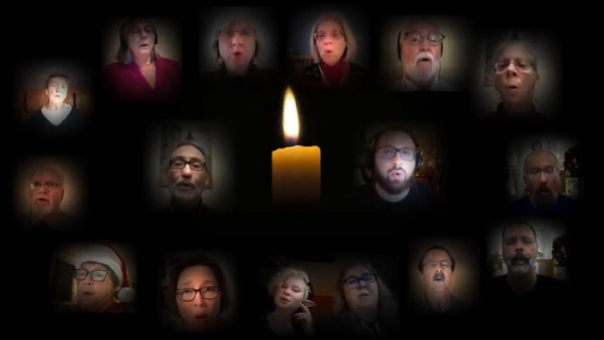
Heritage, and most other churches, were closed for in-person worship in December of 2020. As a result, musicians sought alternate means to provide music for congregants. Last year, Michael Tacy, Music Director at The Gathering at Northern Hills (GNH), produced a video, with the help of representatives of both GNH and Heritage UU Church. The video was of the carol “Silent Night,” #237 in our hymnal. It was also shared during Christmas Eve services for both Heritage and The Gathering.
For some background, we share excerpts from an article written by Susan Lewis in 2020,
“The Story Behind the Beloved Christmas Carol Silent Night.” For the complete article, click on this link: https://www.wrti.org/arts-desk/2020-12-19/the-story-behind-the-beloved-christmas-carol-silent-night
It was 202 years ago when “Silent Night” was first heard by Austrian villagers attending Christmas Eve mass in St. Nicholas Church in Oberndorf. It’s a song about a calm and bright silent night, and the wonder of a tender and mild newborn child, words written in 1816 by a young priest in Austria, Joseph Mohr, not long after the Napoleonic wars had taken their toll.
It was Christmas Eve, 1818, when the now-famous carol was first performed as Stille Nacht Heilige Nacht. Joseph Mohr played the guitar and sang along with Franz Xaver Gruber, the choir director who had written the melody.
An organ builder and repair man working at the church took a copy of the six-verse song to his home village. There, it was picked up and spread by two families of traveling folk singers, who performed around northern Europe. In 1834, the Strasser family performed it for the King of Prussia. In 1839, the Rainer family of singers debuted the carol outside Trinity Church in New York City.
The composition evolved, and was translated into over 300 languages with many different arrangements for various voices and ensembles. It was sung in churches, in town squares, even on the battlefield during World War I, when, during a temporary truce on Christmas Eve, soldiers sang carols from home. “Silent Night,” by 1914 known around the world, was sung simultaneously in French, German and English.
Over the years, the carol’s mystique grew with its popularity. After the original manuscript was lost, for decades, some speculated that the music had been written by Haydn, Mozart or Beethoven. In 1994, an original manuscript was found in Mohr’s handwriting, with Gruber named as composer.
Listen to the YouTube video Silent Night.
